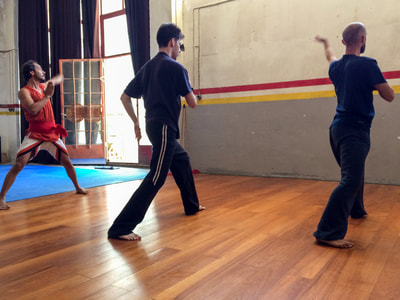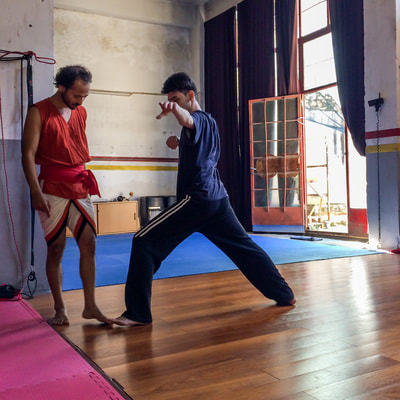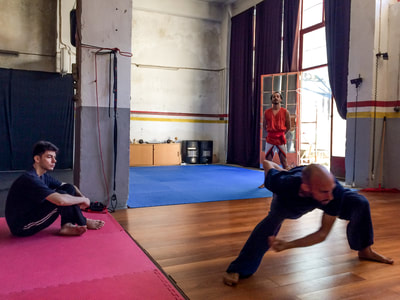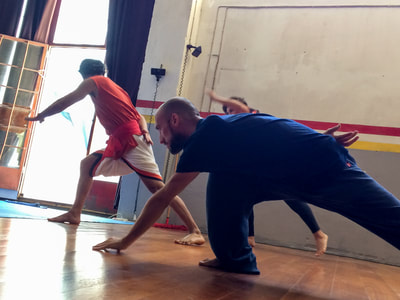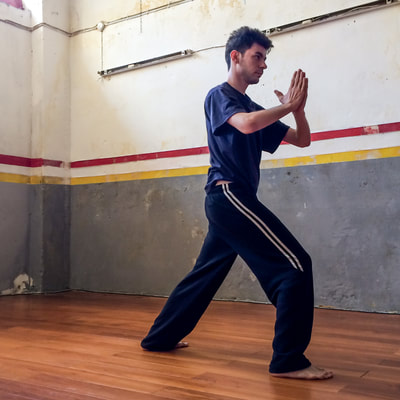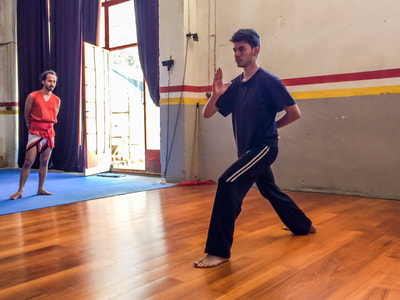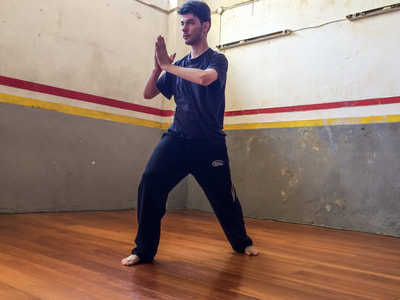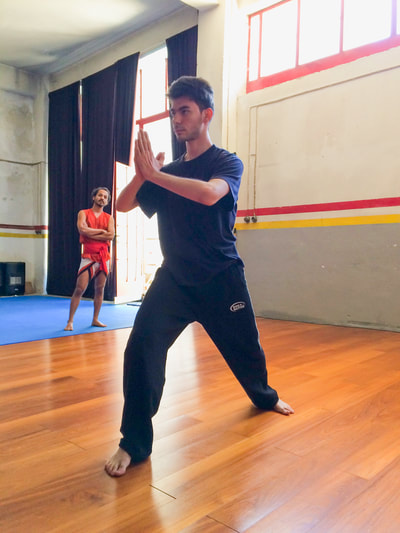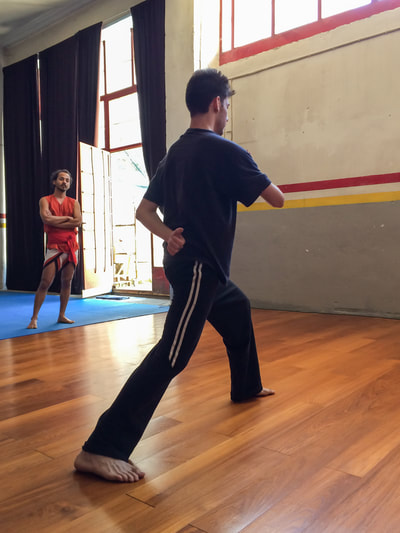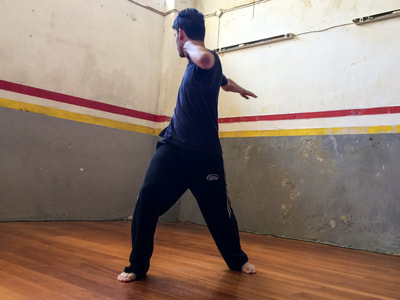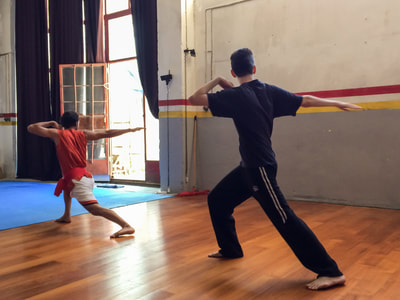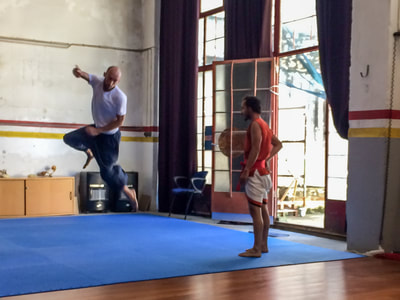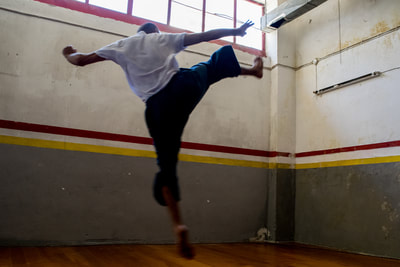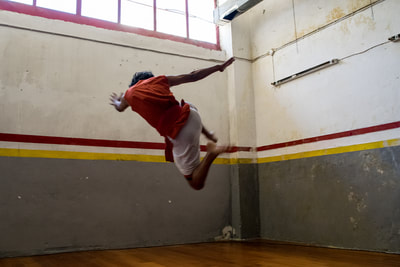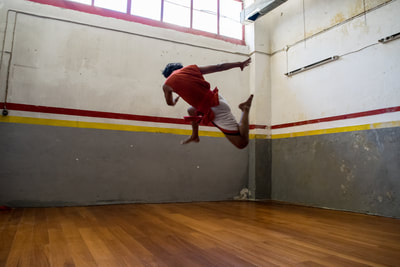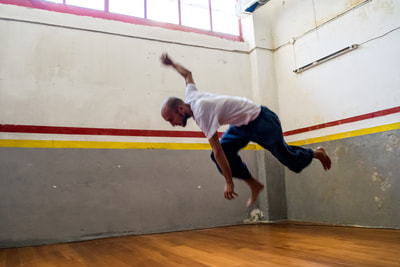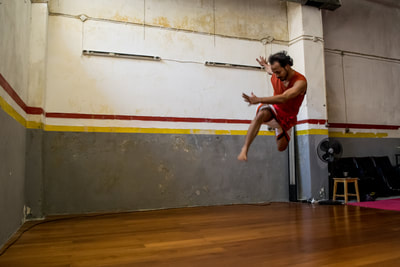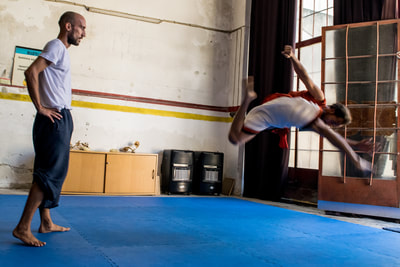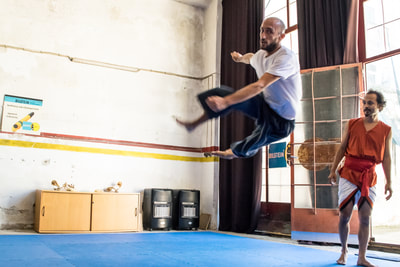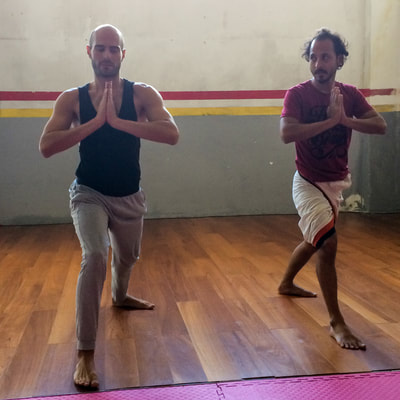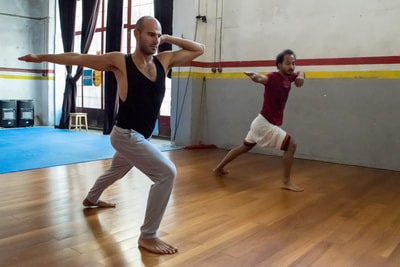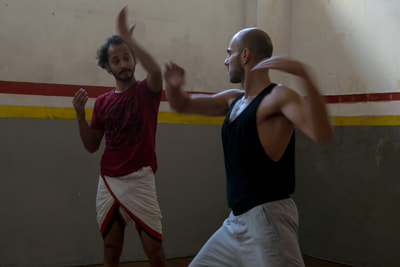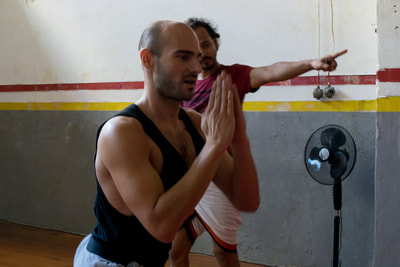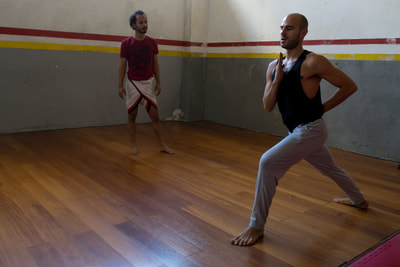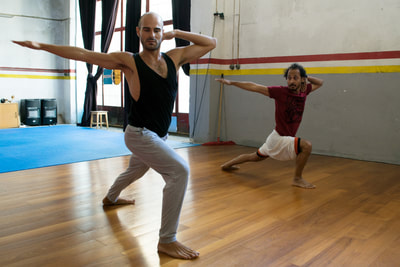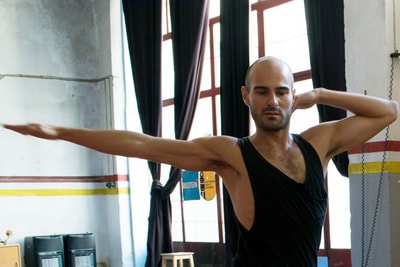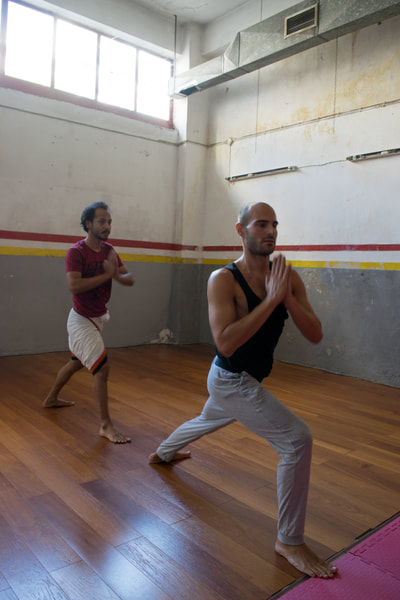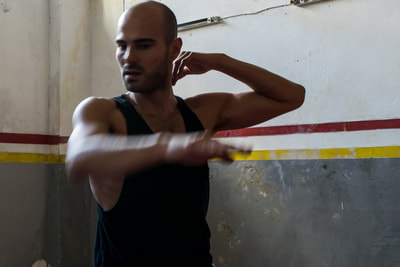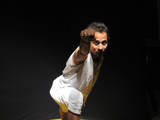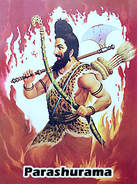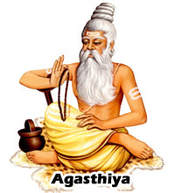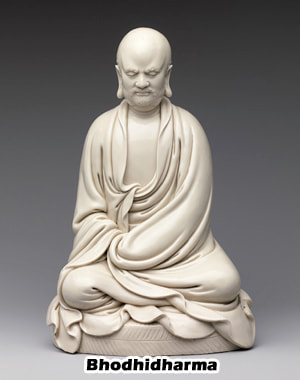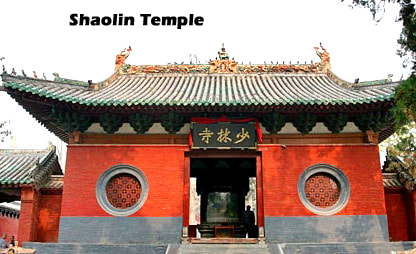KALARIPAYATTU with JAYANTA CHATTERJEE
Kalaripayattu sessions from September 24 to October 12, 2018 with Jayanta Chatterjee
@konstantinoupoleos aka neverland, Kolonos, Athens, Greece
@konstantinoupoleos aka neverland, Kolonos, Athens, Greece
|
|
On the occasion of his presence in Athens, Jayanta Chatterjee will teach in one 2 hour Kalari session at Space konstantinoupoleos aka neverland from September 24 to October 12, 2018 every day.
More information - bookings at 6944 301678 & 210 9214248 or [email protected] |
Φωτογραφίες από τις συναντήσεις kalaripayattu που έγιναν στον χώρο της neverland από τις 24 Σεπτέμβρη μέχρι τις 12 Οκτώβρη 2018
Photos from the kalaripayattu meetings that took place in the neverland space from September 24 to October 12, 2018
Photos from the kalaripayattu meetings that took place in the neverland space from September 24 to October 12, 2018
Kalaripayattu History (from http://www.kalaripayattubangalore.com)
|
Existence of Martial arts in India for over 3000 years can be proved by the mention of martial arts in the Vedas. According to ancient folklore, Lord Vishnu’s disciple Parasurama who was an avatar of Lord Vishnu is believed to be the founder of martial arts in India. Kalaripayattu, which is the most popular amongst many martial arts practiced in India, is believed to have been founded by Parasurama. Kalaripayattu is probably the oldest form of martial arts in India. The word kalaripayattu is a combination of two words, namely, ‘kalari’ and ‘payattu’ which mean training ground and fight. Kalaripayattu is an ancient art form and is considered to be one of the oldest forms of martial art in Indian and across the world. During the peak of its popularity, kalaripayattu was used as a code of combat by the South Indian dynasties. Kalaripayattu reach its zenith during the hundred years of war between the Cholas, Pandyas and Cheras. The constant fighting between the princely states helped the fighters in refining the art into a martial art form.
|
Many martial arts in India have been forgotten due to neglect and lack of proper documentation of their existence but kalaripayattu has stood the test of time. During the 13th and 16th centuries, the art gained dominance and was incorporated into many religions as well. It was customary in Kerala to have all children above the age of seven to obtain training in kalaripayattu. Martial arts in India were considered as a code of life for many. However, during the British occupation, martial arts in India suffered major set backs. The ruling British objected to the tradition of training with and carrying arms. Laws were passed and were implemented with zest to prevent the people from practicing and training in kalaripayattu. These laws were put in place by the British to quell the chances of any form of mutiny or rebellion among the natives. But the British had underestimated the love of martial arts in India and kalaripayattu was secretly practiced and kept alive during the colonial occupation of India by the British. The art was practiced by people in rural areas to avoid an confrontation with the authorities. Thus, one of the main martial arts of India survived the dark times where curbs were imposed on its practices. On being declared independent, martial arts in India were in vogue again as they could now be practiced without hesitation. Lost glory of kalaripayattu was regained slowly and steadily. Many movements and postures in the art of kalaripayattu are believed to be inspired by the raw strength of animals and are also named after them. There is a strong belief that this art was developed in the forests when hunters had observed the fighting techniques of different animals.
|
Kalaripayattu means Practicing the arts of the battlefield. Kalari means battlefield. Kalaripayattu is sometimes in short called as Kalari. It is today more prevalent in the south Indian state of Kerala. This art is said to have had its origin with Rishi Agastya and Parashurama. Agastya is a great name in Ayurveda – the main Indian medical system. Parashurama is also said to have reclaimed the submerged Kerala from the Arabian Sea (Will write on this aspect of Kerala someday)
The oldest reference to this martial art is found in the Rigveda and Atharvaveda. In Rigveda it is mentioned that lord Indra defeated the daemon Vritasura using one of the marmam techniques of Kalari. Marmam are pressure points in the human body and experienced practitioners can disable or kill their opponents by a mere touch of the opponent’s Marmam. This technique is taught only to the promising and level headed persons, to prevent its misuse. |
Today martial arts in India are back in focus. Kalaripayattu is now practiced widely across Kerala, fringes of Karnataka and Tamil Nadu and also in Sri Lanka. Kalaripayattu is also a source of living for many people in Kerala as performances are now conducted for tourists. Kalaripayattu has been stood the test of time unlike many other martial arts in India. Historically, kalaripayattu has proven to be one of the most ancient martial arts in India and is still being practiced by many in Southern India.
Shiva was said to have taught Parasurama, the art of Kalaripayattu, which arised itself out of Shiva's war with his Father-In-Law Daksha, one of the Prajapatis or 'Lords Of Creation'. Later, Parasurama taught his 21 disciples the art of Kalaripayattu, and then opened 108 Kalari (school's/gymnasiums) around the Kerala region, Southern Indian state.
There are no records that chronicle the historical origins of Kalaripayattu, only narrative accounts formatted as myth and legend. Most of these credit Kalari's origins to Lord Shiva, one of the three principle Gods of the Hindu pantheon. Shiva has many aspects, he is depicted as moral and paternal, also called, the Lord of Time(mahakala), the 'Destroyer' of all things. He is the Yogeshwara who dwells in Kailas, deep in the meditation that maintains this very existence.
Shiva was said to have taught Parasurama, the art of Kalaripayattu, which arised itself out of Shiva's war with his Father-In-Law Daksha, one of the Prajapatis or 'Lords Of Creation'. Later, Parasurama taught his 21 disciples the art of Kalaripayattu, and then opened 108 Kalari (school's/gymnasiums) around the Kerala region, Southern Indian state.
There are no records that chronicle the historical origins of Kalaripayattu, only narrative accounts formatted as myth and legend. Most of these credit Kalari's origins to Lord Shiva, one of the three principle Gods of the Hindu pantheon. Shiva has many aspects, he is depicted as moral and paternal, also called, the Lord of Time(mahakala), the 'Destroyer' of all things. He is the Yogeshwara who dwells in Kailas, deep in the meditation that maintains this very existence.
How other martial arts derived from Kalaripayattu (from http://www.kalaripayattubangalore.com)
The ethnic Indian martial art of Kalari Payat (Kalaripayattu) - meaning 'Battleground' or 'Gymnasium' - (Kalari), 'Method' or 'Art' - (Payatt), has a special significance for practitioners of the Tibetan and Chinese martial arts.In tradition, the Shaolin Temple martial art of China was introduced by the Indian Buddhist Patriarch and founder of Ch'an' (Zen) Buddhism; Bodhidharma (450-523 AD).
The ethnic Indian martial art of Kalari Payat (Kalaripayattu) - meaning 'Battleground' or 'Gymnasium' - (Kalari), 'Method' or 'Art' - (Payatt), has a special significance for practitioners of the Tibetan and Chinese martial arts.In tradition, the Shaolin Temple martial art of China was introduced by the Indian Buddhist Patriarch and founder of Ch'an' (Zen) Buddhism; Bodhidharma (450-523 AD).
|
Bodhidharma known in Chinese as 'Dat-Mo' was the 28th Patriarch in the dhyana (Sanskrit for meditation and hence Ch'an and Zen) Buddhist tradition of India.He had been invited to China by the Emperor Wu, an ardent Buddhist. Bodhidharma later retired to the Shaolin Temple, and according to legend instructed the Monks there in a series of exercises that went on to form the basis of Shaolin Temple 'boxing'. These exercises are recorded as martial arts techniques and forms from India, or, simply calisthenics, as identified in the 'I Chin Ching' or "Muscle Changing Classic". Extended wall paintings and murals at the Honan Shaolin Temple in North East China show ethnic Indian Monks sparring and training in boxing skills with Chinese Monks, supporting the view that Bodhidharma's exercises were in fact martial arts - the martial arts of his homeland - India. Ancient buddhist monks who travelled from India to China to spread buddhism are said to have taught these martial arts to the Chinese.
The very sparse written historical details that exist today, about Kalaripayattu, dates back to between the 9th and 12th centuries AD. Obviously, this is much too late for the arts origins given the teachings of Bodhidharma, and the long martial heritage of India, known to the Persian Empire (circa 6th Century BC) and the Hellenistic Empire of Alexander the Great (4th Century BC). It is however, well within the time frame for a transmission (along with Tantric Buddhism) to Tibet, and for the period of Ah-Dat-Tor Lama, founder of the Tibetan Lion's Roar Lama martial art (Circa 1426 AD) - see below. |
Nevertheless, Bodhidharma, is remembered in the Kerala Region of Southern India - the Homeland of Kalari, as both a lineage Kalari Master, AND, as the Father of Han-Chinese Shaolin 'Kung-Fu'. Kalari Payat has many similarities with Chinese martial arts. There is a division into Northern and Southern styles. There is a separation of systems and techniques into 'external' and 'internal' categories. There is a medical tradition (in Kalari: Ayurveda), there is a vital point discipline (in Kalari: Marma-adi), there is a 'spiritual' aspect that covers both orthodox faiths such as Hinduism, Buddhism and Islam, and also, as in Chinese Kung-Fu a demonology and the use of alters. There is a strong weapons training tradition in Kalari, indeed in some systems the empty hand arts are secondary - as in some South-East Asian martial disciplines.Kalari has many distinct practices too, the use of massage to prepare the fighter for the rigors of training can last a period of several months. The 'Kalari' or Gymnasium - particularly in the Southern systems is constructed as a ritually dug pit of specific dimensions.
Kalaripayattu today, is still practiced in the same manner as it was hundreds and probably thousands of years ago, the rural traditions of India keeping its original practices very much alive and unaltered, in large contrast to much of Mainland Chinese Kung-Fu - which has undergone great change since the homogenization of the Cultural Revolution.
Kalaripayattu today, is still practiced in the same manner as it was hundreds and probably thousands of years ago, the rural traditions of India keeping its original practices very much alive and unaltered, in large contrast to much of Mainland Chinese Kung-Fu - which has undergone great change since the homogenization of the Cultural Revolution.
|
The Shaolin temple itself was founded by an Indian Dhyana master Buddhabhadra. On one of the walls of the Shaolin temple a fresco can be seen, showing south Indian monks, teaching the Chinese the art of bare-handed fighting. On this painting (see image below) are inscribed: Tenjiku Naranokaku which means: the fighting techniques to train the body (which come) from India.
Please note that Buddhism was born in India and then spread to rest of the world including China, Japan, Thailand, Srilanka, Burma, Cambodia, Indonesia etc.As a Chinese Ambassador to USA, Hu Shih once said India conquered and dominated China culturally for 20 centuries without ever having to send a single soldier across her border.. He was referring to the spread of Buddhism into China. |
This author was astonished in 1982 to witness a British BBC television documentary entitled: "The Way Of The Warrior": 'Kalari, the Indian Way'. The opening film sequence was of a Southern Kalaripayattu Guru (Master) performing a traditional 'Form' that was near identical to a Tibetan Lion's Roar Lama Kung-Fu form that he had learned! This was despite a separation between the arts of many hundreds of miles and several hundreds of years. The connection was real, present and obvious.
An intriguing suggestion has been made by several prominent martial arts historians, notably Tatsuo Suzuki, Hirokazu Kanazawa, and Masutasu Oyama, that the Greek Martial Art of Pankration (all Powers) introduced into India by the army of Alexander the Great in the 4th Century BC, influenced the development of Kalari, and thence, the martial arts of China, Tibet, Japan, Okinawa and South-East-Asia. The Greeks remained in India and Afghanistan for three hundred years, during which time Greek (Hellenistic) culture pervaded that of India, even influencing China and Japan.
Today, mainly for reasons of national pride, many Chinese reject out of hand the possibility of any effect on Kung-Fu from Greek Pankration. The Japanese and Okinawan's, who openly acknowledge the influence of Kung-Fu on their arts are less reticent.
An intriguing suggestion has been made by several prominent martial arts historians, notably Tatsuo Suzuki, Hirokazu Kanazawa, and Masutasu Oyama, that the Greek Martial Art of Pankration (all Powers) introduced into India by the army of Alexander the Great in the 4th Century BC, influenced the development of Kalari, and thence, the martial arts of China, Tibet, Japan, Okinawa and South-East-Asia. The Greeks remained in India and Afghanistan for three hundred years, during which time Greek (Hellenistic) culture pervaded that of India, even influencing China and Japan.
Today, mainly for reasons of national pride, many Chinese reject out of hand the possibility of any effect on Kung-Fu from Greek Pankration. The Japanese and Okinawan's, who openly acknowledge the influence of Kung-Fu on their arts are less reticent.
Kalari and Tibetan Martial Arts: The Tibetan Lion's Roar! Lama, Potala Palace Martial Art: the martial art of the Tibetan Nation and People; is a Tantric Yana in it's own right. The art becomes known to narrative history in the middle of the 15th century AD, when the Lama Ah-Dat-Tor, a Tantric Siddha (Crazy Wisdom Teacher), and student of Dharma Master Gong-Got Lama, at the Potala's famous: Namgyal or "Victorious" Monastery, 'created' the Lion's Roar! martial art through a Tantric meditative and Yiddam (Deity Meditation) process, making Lion's Roar Lama Potala Palace Kung-Fu, part of the Gelugpa or "Yellow Hat" school of Tibetan Buddhism, a part of the lineage sect of the Dalai Lama himself.This is as far as the oral narrative histories, can take us. However, broader anthropological research can offer the potential for further insight.The 'Potala': Early legends concerning the Red Mountain at Lhasa, tell of a sacred cave, considered to be the dwelling place of the Bodhisattva Chenrezig that was used as a meditation retreat by Emperor Songtsen Gampo in the seventh century AD. In 637 King Songtsen Gampo built a palace on the 'Red Hill/Mountain' at Lhasa. From as early as the eleventh century the Palace was called Potala. The name probably derives from Mt. Potala (Sanskrit: Potalaka - derived from the Tamil for 'Brilliance' or 'To Light a Fire') the mythological mountain abode of the Bodhisattva Chenrezig (Indian - 'Avilokiteshvara', Han- 'Kuan Yin') in the Kerala region of Southern India. The Potalaka is sacred to Hindu's, Jains and Buddhists. The Tibetan King Songtsen Gampo has been regarded as an incarnation of Chenrezig (as indeed were all the subsequent incarnations of the Dalai Lama). As he founded the Potala, it seems likely that the Mountain top Palace of Lhasa took on the name of the Indian sacred mountain.
Given this, and given that The Lion's Roar (as part of the Lotus Sutra) was originally a Theravada Arhat teaching, it seems likely that very early Bcuddhist influence (Theravadian) may well have entered into Tibet, and settled near to the Potala Mountain. The Lion's Roar! Tibetan martial art, is acknowledged to have been influenced by the Indian martial art of Kalaripyattu. Some narrative histories make direct claim that Ah-Dat-Tor was trained in Kalari, and, some martial arts forms from the 'Southern' style of Kalaripayattu, from the Kerala district, are very close indeed in technique and sequence to modern Lion's Roar forms, even without any evidence whatsoever of any recent historical contact between the systems. This fact was recorded in a BBC Television film documentary in 1981: "Kalari, the Indian way" which shows a Southern Kalari Master performing a martial arts form near identical to one found in a branch lineage from the Chan-Tat-Fu line of Tibetan Hap-Gar Kung-Fu. Given that the Sacred Mountain of Potala is in Southern India, a potential link to Southern Kalari martial arts is obviously evident (see above).
Given also that Gong-Got Lama (Dharma Master) was also a teacher of martial arts at the Potala to Ah-Dat-Tor Lama, it may well be that Southern Indian Kalaripayattu together with its sister art Simhanada Vajramukti, was already present at Lhasa, and taught on the Potala Red-Hill for many generations before 'Lion's Roar' as we know it (exclusively through Han Chinese lineages) was 'formulated' by Ah-Dat-Tor himself.
The transformation of the Arhat (Theravadian) tradition into the Mahayana Bodhisattva, may mirror the transformation of Indian Kalaripayattu into Tibetan Lion's Roar Lama 'Kung-Fu'. Named Arhat forms still exist in some extant Han 'Tibetan' Hop-Gar, Lama and White Crane Kung-Fu lineages, that all arise from the original Lion's Roar of Ah-Dat-Tor. Bodhisattva forms also exist, showing the mixture of traditions. Indeed some Tibetan lineages in Hop-Gar claim that their Tantra is from the Karmapa 'Black-Hat' tradition, which cannot be the case if Ah-Dat-Tor was a Monk at the Potala, unless, further influence occurred after Ah-Dat-Tor's time, which seems to be the case.
Nevertheless, Ah-Dat-Tor's art, as originated by him, or as 'ascribed to him', albeit arising from a Kalari root, has further diversified into many branches. To be authentically 'Tibetan' however, the Lion's Roar! Lama 'Kung-Fu' MUST be Tantric in form and practice, this is the essential root, and must be 'living' even in the Han-diversified or Westernized branches of the art.To be practiced as Tantra, TRUE Lion's Roar! Martial Arts will resemble Japanese 'Zen' martial systems, even more than they do Han Chinese, in respect of their integrated spiritual - Buddhist practices. Just as Karate-Do is the way of the 'Empty' (Zen) Hand, so too is Lion's Roar 'Tantra', in it's integrated body, mind, and spiritual form.
Buddhism has always changed to meet 'local' conditions, in host cultures: Tibet, Thailand, Japan, China, the West etc (e.g. 'Gnostic Buddhism'). Lion's Roar! as a Tantric martial art has also changed and evolved, but, as with Buddhism, and in particular, as with 'Tibetan' Buddhism, the art must have a Tantric core. Then, the Lion's Roar! will still Roar the Buddha's Dharma, and still be a vehicle for transformation and enlightenment, just as it was always intended to be.....
'Tibetan' Kung-Fu has been demonstrated to be related in religion to India thru Tantric Buddhism, and now thru actual research the physical connections in technique and form can be seen as still alive, and still flourishing in Kerala, Southern India, the 'homeland' of Kalari, which is perhaps the 'Mother Art' for both Tibetan and Han Chinese 'Kung-Fu'......

